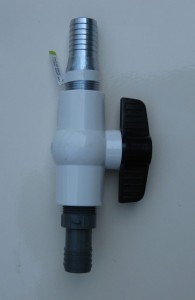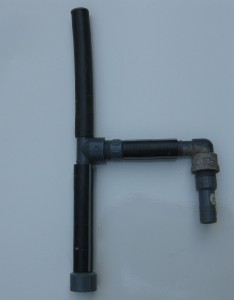Blockages in the rainwater harvesting system
With rainwater harvesting whatever can go wrong does. After fall I cleared my gutter of leaf debris and left it at that. Silly me! I didn’t consider that the 2″ pipe from the downspout outlet to the storage tank might be clogged with leaves. It was only when rainwater collection by the one tank was less than expected and when, during a downfall, I saw rainwater cascading over the gutter, that I figured I had a problem.
Clearing the blockage was not too difficult. I removed what I could by hand and then expelled the rest with water pressure from the hose. I decided in future to use a mesh screen in the outlet to catch leaves before they enter the pipe. However, I also needed a simple means for identifying and preventing the recurrence of future blockages.
Rather than spray water from the hose onto the roof and let it dribble into the gutter I cobbled together a simple fixture which is attached to a hose and, with the aid of a long stick (or broom), hoisted in place over the gutter. The hose is switched on and water enters the gutter, the downspout and then (audibly) the tank. The bottom left link (in the picture) is attached to the hose. The top left link is sealed and its purpose is probably redundant. Water enters from the bottom left, veers right at the tee and then down at the elbow into the gutter.
How a drip of rainwater produces a flood
The other problem I encountered with my rainwater harvesting was unexpected rainwater loss. During my 7 day vacation to the West Coast there was 0.5″ of rain. I expected all my catchment tanks to rise. However, the carport tank level did not go up, in fact it fell. I did not give this too much thought until I noticed how wet the gravel was around the lower level storage tanks and I then noticed that a connector at the lower level was copiously leaking rainwater from the higher level carport tank. I measured the rainwater loss and it was 250ml in 1 minute (metric is so much easier to use). Which equates to 1 litre in a 4 minutes and therefore 15 litres in an hour. I was gone 7 days which is 168 hours (7×24) which is 2,520 litres (168×15) which is 665 gallons (2,520x.264). So in 1 week I lost approximately 670 gallons of rainwater.
The carport has a length of 27 ft and a width of 24 ft. So the capture/catchment area is 648 sq. ft (27×24). There are 7.48 gallons of water per cubic ft. The recent 0.5″ of rainfall on the carport produced 27 cubic ft of rainwater (648 sq ft x 0.5″/12) which equates to 202 gallons (27 cu ft x 7.48 gal/cubic ft). When I left on vacation I had approximately 500 gals and with the rainfall there should have been say 700 gals and when I returned there was barely any water because I had lost almost 700 gals from leakage.


My solution was two fold: 1) tighten the clamp at the fitting; 2) since the fitting was at the bottom of the hill where water pressure is greatest, I inserted a second valve at the top of the hill where psi is less and therefore there is less pressure to force a leak. For the second valve I used a steel insert into the high pressure end rather than a plastic insert since steel inserts are longer and provide a tighter fit. Hopefully this ends my rainwater losses and my rainwater harvesting will be more efficient.


Here in Europe it’s very common to collect your own rainwater. The system that works here, and nearly everyone uses, involves what we call ‘waterbutts’ or the water containers with only high level pipes. In this way, as the water comes in, it fills the first tank almost completely, then starts overflowing into the second, and so on.
If you leave several inches of space between the top of the waterbutt and the overflow pipe, then it allows for some space in the container in case an unexpectedly large flow of water comes in. This also keeps the waterbutt from filling all the way, which is handy too because otherwise the contents will slosh over the top with the slightest bump.
In this way, you are unlikely to lose any water, because every container is independent so you should never lose all the water and unless there is some kind of failure in the container itself, there shouldn’t be any reason for it to leak.
Yes, then I might hear you say, ‘How do I get the water out?’ or ‘How do I attach a hose to it?’. For most people here, their garden is not so big they can’t just fish water out of the barrel from the top of the barrel with a watering can, or perhaps install a valve on the bottom of each barrel independently. I’ve never seen anyone attach a hose to a waterbutt here, but it should be possible if you really think it’s necessary. If you have a valve on the bottom of each barrel independently, it can still leak, but at least if one fails you only lose the water in that one barrel.
In my garden, I have an even simpler system. I just have independent waterbutts. I have one connected to my greenhouse roof with a hose, and when it rains I go out to my garden with a bucket and move the water into the other containers by hand. This is a little low-tech, but I almost never lose any water.
Thank you for your comments. I agree a valve at the bottom of the container may leak. For us in the Atlanta area the issue was simplified when, several years ago, a popular gardening authority announced the availability of recycled storage tanks. These were used for industrial chemicals, have a capacity of 250 gals (1,000 litres), and initially were sold by a nursery for $90. The price edged up as more gardeners became interested. Then the recommendation disappeared from the authority’s website, perhaps over concern that residues from the formerly stored chemicals could be a problem. I bought several of these useful tanks and they come with a large valve outlet to which I attach my hoses and pipes.
Hi Richard,
We’re on a well which has hard water with iron. We don’t like to use the well water because it is very cold, has lots of iron, and costs $ to pump. Instead, we use 1000 litre food grade storage tanks – https://picasaweb.google.com/108665847651807187576/1000LitreRainBarrels . We have 4 in total and, with the gardens downhill from the tanks, are able to water using a gravity feed. In total, we have 4000 litres. We’ve never run out of water. This summer we went 6 weeks without rain and drew the tanks down to about 1/2. We mulch heavily and water specific amounts directly at the base of plants. It takes time but it means that we waste little water.
Additionally, the tanks are a back up water supply during summer storm induced power outages that leave us with no power to the well pump.
This has worked out very well for us.
Regards,
Mike
Hi Mike,
Thank you for your comments. Approximately where are you located (I was going to ask “where in the world are you” but it sounds flippant).
Are your storage tanks transparent and, if they are, do you have a problem with algae growth? Algae grows in two of my larger transparent tanks (even though they are under a roof, the sides are exposed to the sun) and I am thinking I should paint them black to alleviate this problem. I use bubblers at the end of my gravity feed pipes and they often clog up.
Hi Richard,
Where in the world am I? I often ask myself that. Never get an answer though.
Here: 44.265475, -77.960029
The tanks are white opaque. We’ve got a permanent algae/gunk coating on the walss that hasn’t grown. We rarelyr have a problem with the hose attachment clogging so I assume that either nothing is growing or it’s very minute.
Painting them black might heat up the water. I found that the water that sits in the hose can get very hot and I had to run it away from the plants until tank water ran through the hose. Now I turn the valves off at the tank.
Regards,
Mike
Mike thanks for the directions – you are quite a bit north of me and in a cooler climate, which may also help. My algae looks like seaweed.
I have the same problem with heated hose water – I aim the water at the soil and hope it cools down before it reaches the roots.
Regards,
Richard